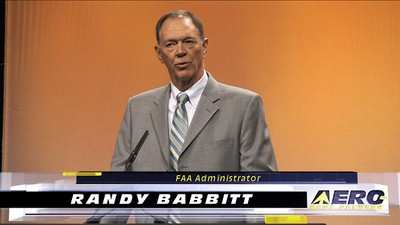Report Covers Broad Areas Of Airline Operation And
Regulation
 The FAA has issued a report that
recaps recent actions to further enhance safety for passengers who
fly on both major and regional airlines. Secretary of
Transportation Ray LaHood and FAA Administrator Randy Babbitt
hosted the 12 Call to Action meetings across the nation with
airlines and unions to strengthen pilot hiring, training and
performance, combat fatigue, as well as improve professional
standards and discipline at both major and regional airlines.
The FAA has issued a report that
recaps recent actions to further enhance safety for passengers who
fly on both major and regional airlines. Secretary of
Transportation Ray LaHood and FAA Administrator Randy Babbitt
hosted the 12 Call to Action meetings across the nation with
airlines and unions to strengthen pilot hiring, training and
performance, combat fatigue, as well as improve professional
standards and discipline at both major and regional airlines.
Eighty two percent of US air carriers representing 99
percent of the commercial fleet and seven pilot unions responded to
the Call to Action with written commitments to implement best
practices and to adhere to the highest professional standards. The
FAA plans to meet with labor organizations in February to further
refine our work. More than 98 percent of air carriers have or plan
to implement a program to routinely monitor safety data to identify
trends and precursor events.
"This report is a snapshot of our work, which is by no means
finished" said FAA Administrator Randy Babbitt. "We will
continue to aggressively push forward with these initiatives that
we believe will raise the safety bar even higher."

The FAA provided a short preview of the report:
Pilot Flight Time, Rest, and Fatigue
FAA Administrator Randy Babbitt has made the creation of new
flight, duty, and rest rules based on fatigue science a high
priority. The FAA is working on an aggressive timeline and will
issue a new proposal this spring.
Almost immediately after joining the FAA in June 2009,
Administrator Babbitt chartered an aviation rulemaking committee
(ARC) of representatives from FAA, industry, and labor
organizations to make recommendations for a science-based approach
to fatigue management. Those recommendations were sent to
Administrator Babbitt in September 2009.
The FAA last proposed updating the rules in 1995 but, based on
industry comments, the rule was not adopted. Since then, the agency
has reiterated the rules and kept pace with a changing industry by
allowing airlines to use the latest fatigue mitigation techniques
to enhance safety.

FAA Oversight
From June 24, 2009 to September 30, 2009, FAA inspectors conducted
a two-part focused review of air carrier flight crewmember
training, qualification, and management practices. The FAA
inspected 85 air carriers to determine if they had systems to
provide remedial training for pilots. The FAA did not inspect the
14 air carriers that have FAA-approved Advanced Qualification
Programs (AQP) because AQP includes such a system. Seventy-six air
carriers, including AQP carriers, had systems to comply with
remedial training requirements. An additional 15 air carriers had
some part of a remedial training system. At the time, there were
nine air carriers that lacked any component of a remedial training
program and received additional scrutiny. Since then, these air
carriers have developed remedial training for pilots. FAA
inspectors observed a total of 2,419 training and checking
events.
First, FAA inspectors met with air carriers’ directors of
operations, directors of safety, and company officials responsible
for flight crewmember training and qualification programs. The
purpose of these meetings was to determine the carrier’s
ability to identify, track, and manage low-time flight crewmembers
and those who have failed evaluation events or demonstrated a
repetitive need for additional training. Inspectors also looked at
whether the carrier adopted the suggestions in Safety Alert for
Operators (SAFO) 06015 to voluntarily implement remedial training
for pilots with persistent performance deficiencies. The FAA has
strongly encouraged carriers without such systems to establish them
and has increased oversight for those air carriers.
Second, inspectors conducted additional inspections to
revalidate that the carrier’s training and qualification
programs meet regulatory standards in accordance with FAA guidance
materials. Inspectors confirmed that the programs review the entire
performance history of any pilot in question, provide remedial
training as necessary, and provide additional oversight by the
certificate holder to ensure that performance deficiencies are
effectively addressed and corrected.
Airline Contract Agreements
Many airlines are now taking steps to ensure that their smaller
partner airlines adopt the larger airline’s most effective
safety practices. The Air Transport Association’s Safety
Council now includes safety directors from the National Air Carrier
Association and the Regional Airline Association in their quarterly
meetings. The agency is encouraging periodic meetings of the larger
airlines and those they have contract agreements with to review
Flight Operations Quality Assurance (FOQA) and Aviation Safety
Action Programs (ASAP) data and to emphasize a shared safety
philosophy.

Pilot Records
While Congress is working to amend the Pilot Records Improvement
Act of 1996 and the FAA amends guidance to airlines, Administrator
Babbitt asked that air carriers immediately implement a policy of
asking pilot applicants to voluntary disclose FAA records,
including notices of disapproval for evaluation events. The
airlines agreed to use best practices for pilot record checks to
produce a more expansive search for all records available from a
pilot's career. The expanded search includes all the records the
FAA maintains on pilots in addition to the records airlines already
receive from past employers. Of the 80 air carriers who responded
to Administrator Babbitt on this issue, 53 air carriers (66
percent) reported that they already require full disclosure of a
pilot applicant’s FAA records. Another 15 percent plan to
implement the same policy.
Professionalism & Experience Transfer
In February, the FAA will host a forum for labor organizations to
further develop an action plan to improve professionalism and
transfer of pilot experience. In the interim, these organizations
have answered the Call to Action and support the establishment of
professional standards and ethics committees, a code of ethics, and
safety risk management meetings between FAA and major and regional
air carriers.
FAA Administrator Babbitt very much favors mentoring as one way
to raise professional standards and improve cockpit discipline. The
FAA plans to continue to explore establishing joint strategic
councils within a “family of carriers.” This approach
could lead to individual, as well as corporate mentoring
relationships. The use of professional standards committee safety
conferences could provide opportunities for two-way mentoring
— a very good reminder that good ideas are not unique to
larger mainline carriers. The FAA is also exploring mentoring
possibilities between air carriers and university aviation
programs.

FOQA and ASAP
The FAA routinely monitors airline industry data to
identify precursors and trends to prevent future accidents. FAA
Administrator Babbitt hasstrongly encouraged air carriers who have
not done so, to establish two important voluntary reporting
programs: FOQA and ASAP to further improvetraining as well as
enhanced operational and maintenance procedures.
Overall, air carriers operating 98 percent of the airplanes in
the commercial fleet have or intend to implement ASAP and air
carriers operating 94 percent of the airplanes in the commercial
fleet have or intend to implement both ASAP and FOQA. Currently, 35
air carriers have FOQA programs, 11 of which were added since last
July. They are: Air Wisconsin, American Eagle, Atlantic
Southeast Airlines, Chautauqua, Compass Airlines, Empire Airlines,
Executive Airlines, Horizon, Mountain Air Cargo, Republic, and
Shuttle American. There are 77 approved ASAP programs covering
pilots, mechanics, flight attendants, and dispatchers. Since July,
Lynx Aviation, Mesa, and Empire Airlines have added ASAP
programs.
FOQA collects and analyzes digital flight data from normal
operations. Some air carriers may be too small or have too limited
operations for FOQA programs to be practical.
ASAP encourages air carrier and repair station employees to
voluntarily report safety information that may be critical to
identifying potential precursors to accidents. Safety issues are
resolved through corrective action rather than through punishment
or discipline. An ASAP is based on a safety partnership that
includes the FAA and the certificate holder, and usually includes a
third party, such as a labor organization.
Pilot Qualifications
The FAA is committed to putting the best trained and
prepared pilots in the cockpits of our nation’s airlines.
While increasing the number of flight hours may be part of the
solution, it is not the sole factor for improving pilot
performance. Pilots must have the quality, mission appropriate
training and experience. The FAA is considering a broader scope of
options.
The FAA has received public comments on a proposal to enhance
traditional training programs for pilots and dispatchers by
requiring the use of flight simulation training for pilots.
However, that proposal did not address basic pilot
certification.
The FAA will soon ask for public input on ways to enhance the
existing pilot certification process. FAA Administrator Babbitt
believes that the type of experience needed to truly improve pilot
performance cannot be measured in flight hours alone. The focus
also needs to be on the quality and scope of training and
experience.

Pilot Training
As mentioned previously, the FAA issued a proposal last
January to enhance training programs by requiring the use of
simulation devices for pilots. More than 3,000 pages of comments
were received. The FAA is now developing a supplemental proposal
that will be issued this spring to allow the public to comment on
revisions.
Based on the information from last summer’s inspections,
the FAA is drafting a Safety Alert for Operators (SAFO) with
guidance material on how to conduct a comprehensive training
program review in the context of a safety management system (SMS).
A complimentary Notice to FAA inspectors will provide guidance on
how to conduct surveillance. SMS aims to integrate modern safety
risk management and safety assurance concepts into repeatable,
proactive systems. SMS programs emphasize safety management as a
fundamental business process in the same manner as other aspects of
business management.
 Aero-News: Quote of the Day (04.28.25)
Aero-News: Quote of the Day (04.28.25) ANN's Daily Aero-Term (04.28.25): Decision Altitude (DA)
ANN's Daily Aero-Term (04.28.25): Decision Altitude (DA) ANN's Daily Aero-Linx (04.28.25)
ANN's Daily Aero-Linx (04.28.25) Airborne-Flight Training 04.24.25: GA Refocused, Seminole/Epic, WestJet v TFWP
Airborne-Flight Training 04.24.25: GA Refocused, Seminole/Epic, WestJet v TFWP Aero-News: Quote of the Day (04.29.25)
Aero-News: Quote of the Day (04.29.25)








